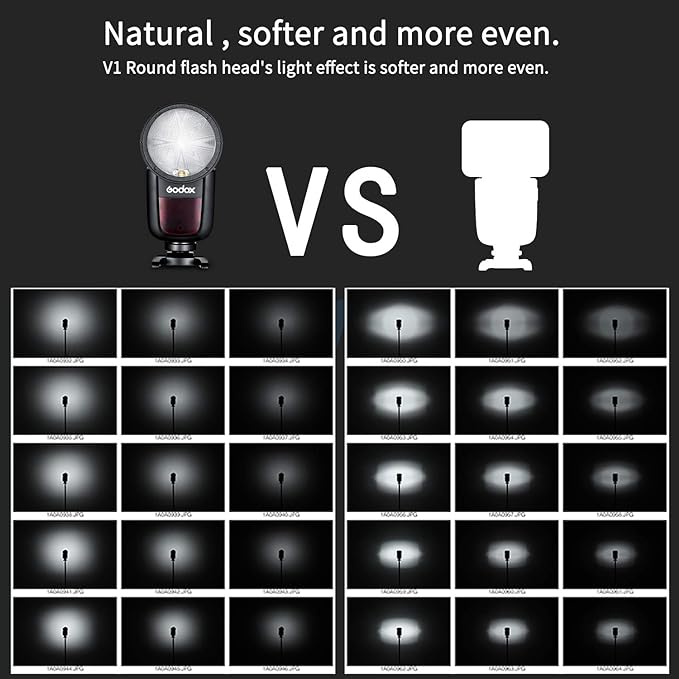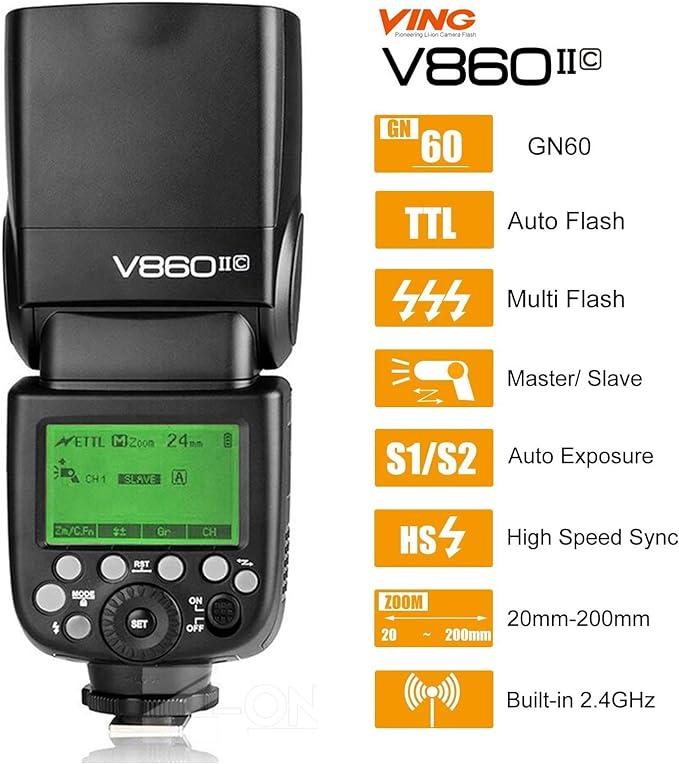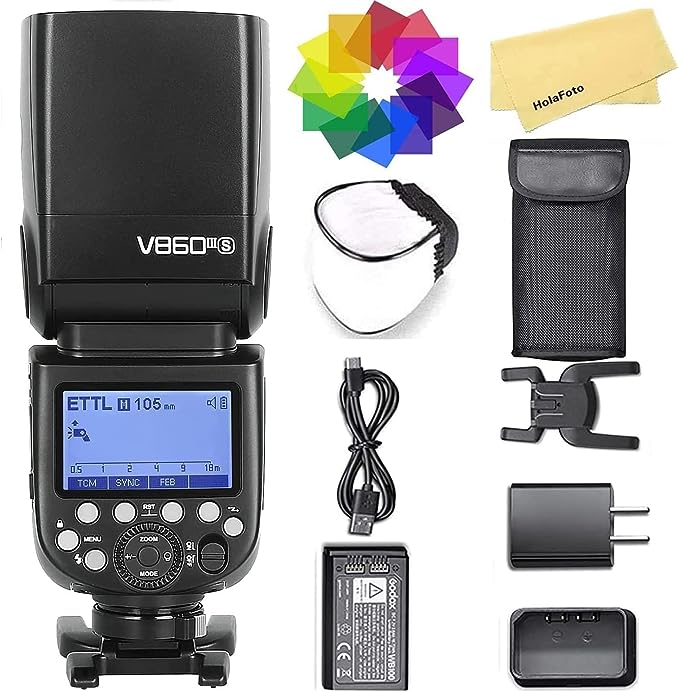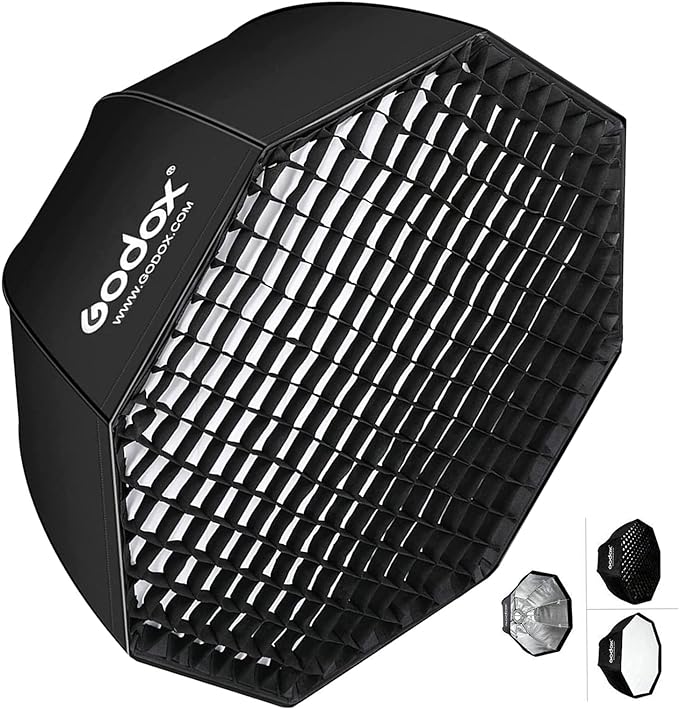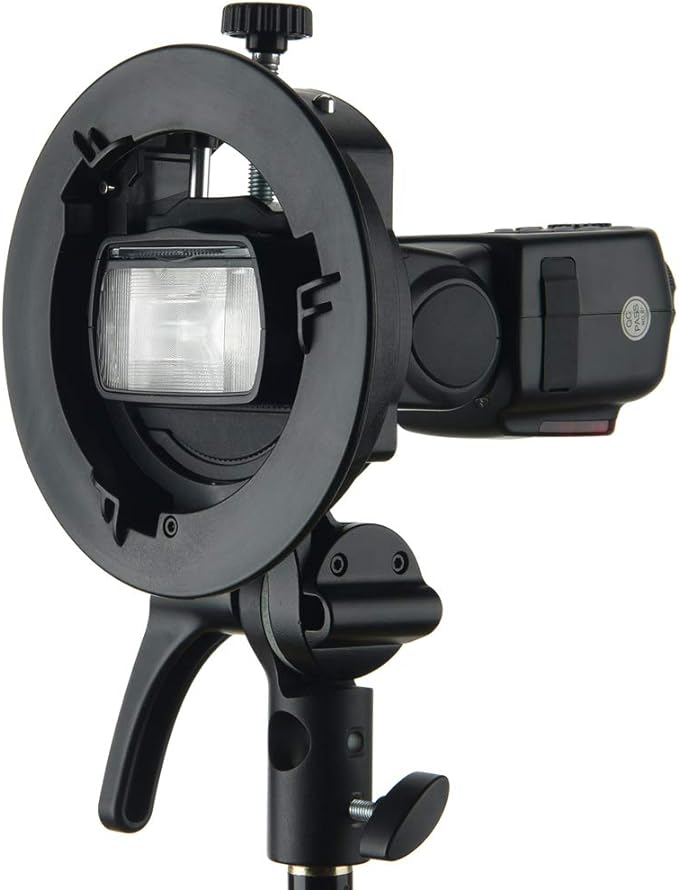In-Depth Comparison: Godox V1 vs V860II vs V860III – Best Godox Flash for Your Photography Needs
In this in-depth comparison, we examine the Godox V1, V860II, and V860III flashes to help you choose the best option for your photography needs. Discover the unique features, strengths, and weaknesses of each model, and get expert advice on which Godox flash is right for you.
If you're looking for a strobe light with more power then check out this article on the Godox AD1200Pro 1200Ws TTL Power Pack.
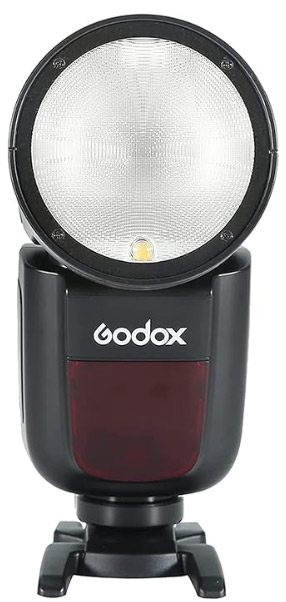
Find Godox V1-C Round Pricing on Amazon
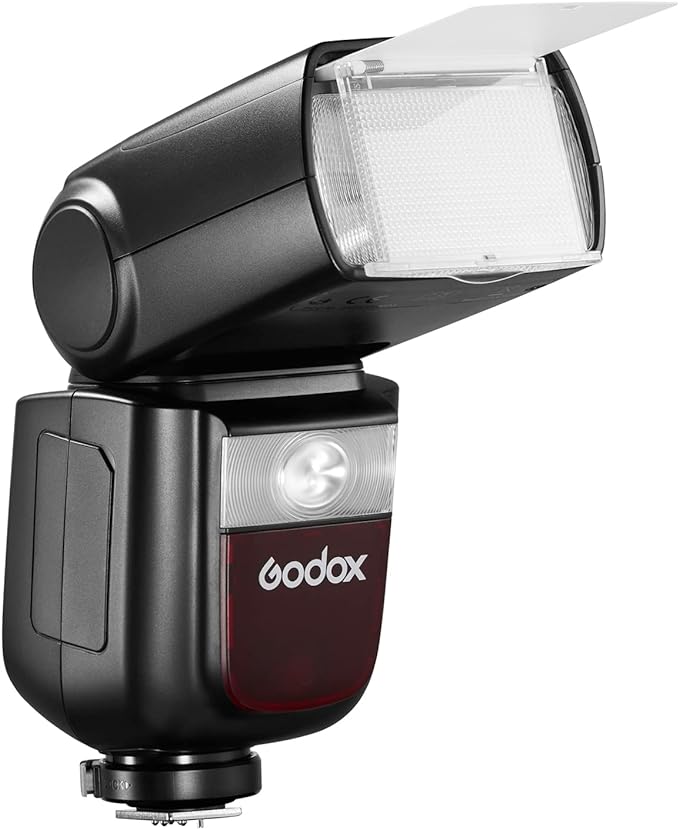
Look up the Godox V860III on Amazon
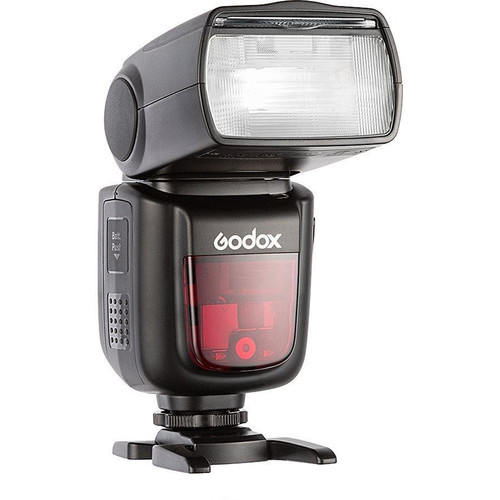
Buy the Godox V860II on Amazon
Overview of Godox Flash Models
A Pro Photographer's Insights on Godox Flash Usage in Commercial Photography
Drawing from his extensive experience in shooting events and portraits for Manhattan Magazine and other high-profile clients, Jeff Fried has developed a deep understanding of the nuances of using handheld flash in commercial photography. His practical knowledge, gained from using various Godox models and competitors, adds a layer of real-world expertise to this comparison.
Handheld Flash in Dynamic Settings
Jeff's preference for handheld flash, particularly in fast-paced event scenarios, highlights the importance of adaptability and quick adjustments. His experiences underscore how each Godox model can cater to these needs in different ways.
Godox V1: A Revolution in Design
The Godox V1, available in variations like the Godox V1 Sony, Godox V1 Canon, and Godox V1 Nikon, stands out with its unique round head design. This design is known to deliver a soft, flattering Godox light that's perfect for portrait shots. Additionally, the Godox V1 flash provides an even spread, reducing harsh shadows. With features like a built-in LED modeling lamp and a magnetic mount, the Godox V1 truly embodies versatility.
You need to make sure you buy the correct variation for your specific camera brand: Sony, Canon, or Nikon. The Godox V1 for a Canon will not work with a Nikon or Sony while the Nikon version won't work with Sony or Canon, and so on.
Photographer's Experience with Godox V1
Known for its unique round head design, the Godox V1 has been a go-to for Jeff in scenarios where soft, flattering light is paramount. He particularly appreciates the even light spread and the built-in LED modeling lamp for its versatility in portrait setups.
Godox V860II: The All-Rounder
The Godox V860II, also referred to as the Godox 860II, is the predecessor to the V860III. It provides a solid performance that's hard to overlook. It boasts a powerful output, making it a favorite for many. For those using Canon, Sony, or Nikon, the Godox flash has a unique model compatibility for each brand that ensures seamless integration. Be certain you buy the correct model for your camera brand. The built-in wireless X-System trigger in the Godox V860 series reinforces its position as a versatile Godox speedlight option. If you want to use the flash off-camera, the X-System requires a transmitter on the hot shoe of your camera — the transmitter also needs to match your camera brand.
Real-World Application by Pro Photographer
Jeff has often leveraged the Godox V860II's powerful output in various events. Its reliable performance and compatibility across camera brands have made it a staple in his photography kit, especially in situations where consistent output and rapid recycling are critical.
Learn more about Jeff here.
Buy the Godox V860II on Amazon
Godox V860III: The Game-Changer
Building on the foundation of the Godox V860 series, the V860III is the most recent addition. With a zoom range of 20-200mm and features like a quick release locking mechanism, the Godox V860III seeks to redefine on-camera flash standards. The debate between Godox V1 vs V860III often boils down to specific use-case scenarios given their distinct features.
Professional Photographer's Take on V860III
The most recent addition to the Godox lineup, the V860III, aligns well with Jeff's need for a quick release locking mechanism and a broad zoom range. This model's versatility has proven beneficial in his wedding and event photography, offering flexibility without compromising on quality.
Buy the Godox V860III on Amazon
Comparing Round Head vs. Rectangle Head Flashes: Which is Better?
Introduction to Flash Head Shapes
In this section, we explore the differences between round head and rectangle head flashes, focusing on how each shape affects light distribution and overall performance.
Round Head Flashes
Round head flashes, like the Godox V1, are designed to mimic the natural light spread of traditional studio lights. This design helps create a softer and more even light distribution, reducing harsh shadows and providing a more natural look to your photos. The round head is particularly beneficial for portrait and event photography, where flattering lighting is crucial.
Rectangle Head Flashes
Rectangle head flashes, such as the Godox V860III and Godox V860II, offer a more directed light output, which can be useful for creating dramatic lighting effects and highlighting specific areas of a scene. These flashes are versatile and well-suited for various photography styles, including product and macro photography.
Performance Comparison
When comparing the performance of round head and rectangle head flashes, it ultimately comes down to the specific needs of the photographer. Round head flashes provide a more natural light spread, making them ideal for soft and flattering lighting, while rectangle head flashes offer more control and precision, suitable for a range of creative lighting techniques.
Godox Modifiers and Accessories
When considering any Godox flash, it's essential to note the available modifiers and accessories. These tools can greatly enhance the quality of light, whether you're using the Godox V1 Canon, Godox V1 Nikon, or any other variant.
If you are adding modifiers to your flash head, like a soft box or lantern, be certain purchase the Godox S2 Speedlite Bracket. This is a Bowens mount. Without it you will not be able to attach your modifier to your flash head.
If you want to create soft light then you should consider the Godox SB-UE Umbrella Octagon Softbox 47.5inch. If you want hard light, then keep your flash head bare-bulb.
Want to better understand different kinds of light sources and how they effect photography? Check out this article titled "Understanding Hard Light vs Soft Light in Photography".
Photographer's Modifier Recommendations
In line with his practical approach, Jeff recommends specific modifiers like the Godox SB-UE Umbrella Octagon Softbox for softer light and highlights the necessity of the Godox S2 Speedlite Bracket for attaching these modifiers efficiently.
Use-case scenarios for Godox Flashes
Here are some specific use-case scenarios where each flash might be a better choice:
Godox V860III for Professional Photography
Wedding photography
The V860III's wide zoom range makes it ideal for wedding photography, where you may need to switch between wide-angle and telephoto lenses quickly.
Event photography
The V860III is also a good choice for event photography, where you may need to bounce the flash off of walls and ceilings to create a more flattering light.
Godox V1 for Professional Photography
Portrait photography
The V1's round flash head produces more flattering light for portrait photography.
Product photography
The V1's round flash head is also a good choice for product photography, where you want to avoid harsh shadows.
Ultimately, the best way to decide which flash is right for you is to consider your specific needs and budget.
Interested to learn more about lighting for photography, check out this article, "Studio Lighting for Photography".
Best Settings for Godox Flashes in Different Photography Scenarios
Event Photography Flash Settings
In dynamic and fast-paced environments like events, quick adjustments and reliability are crucial. The Godox V860III settings:
- Mode: TTL for automatic exposure adjustments
- Power: Start with 1/4 power and adjust as needed
- Zoom: Auto to match the lens focal length
- Modifiers: Use a bounce card or dome diffuser to spread the light evenly
Product Photography Flash Settings
For product photography, control and precision in lighting are essential. The Godox V860II settings:
- Mode: Manual for consistent output
- Power: 1/16 – 1/2 power to control highlights and shadows
- Zoom: Set to 35mm for a broader light spread
- Modifiers: Use a light tent or reflectors to eliminate harsh shadows
Thoughts on Best Flash Settings with Godox
Understanding and using the appropriate flash settings for different scenarios can enhance your photography significantly. Experiment with these settings on your Godox V1, Godox V860II, and Godox V860III to achieve the best results in your specific photography needs.
User Experience & Feedback with Godox Flash Units
The Godox V1 Sony model, for instance, has received praise for its seamless integration with Sony cameras. The Godox V860II, or Godox V860III, has been lauded for its reliability and ease of use.
Godox V1 Sony Model User-Experience
The Godox V1 Sony model has received praise for its seamless integration with Sony cameras. It is fully compatible with Sony's TTL and HSS systems, and it can be controlled directly from the camera's menu system. This makes it very easy to use and configure, especially for Sony shooters.
In addition, the V1's round flash head is a big hit with users. It produces more natural-looking light than a traditional rectangular flash head, which is ideal for portrait and product photography.
Here are some specific user comments about the Godox V1 Sony model:
- "This flash is amazing! It's so easy to use and the integration with Sony cameras is seamless. I highly recommend it to any Sony shooter."
- "The round flash head is a game-changer for portrait photography. It produces such beautiful, soft light."
- "This flash is incredibly reliable. I've used it for hundreds of weddings and events and it's never let me down."
Godox V860II User-Experience
The Godox V860II is another popular flash that is known for its reliability and ease of use. It is also fully compatible with TTL and HSS systems, but it does not have the same level of integration with Sony cameras as the V1. However, it is still a very popular choice for Sony shooters because it is affordable and reliable.
Here are some specific user comments about the Godox V860II:
- "This flash is a great value for the price. It's easy to use and produces great results."
- "I've been using this flash for years and it's never let me down. It's a very reliable workhorse."
- "This flash is a great option for beginners and experienced photographers alike. It's easy to use and produces great results."
Overall, both the Godox V1 and V860II are excellent flashes. The V1 is a better choice for Sony shooters who want the best possible integration and a round flash head. The V860II is a better choice for photographers who are looking for an affordable and reliable flash.
The Godox V860III is a newer flash than the V860II, and it has a number of improvements, including:
- A wider zoom range (20-200mm vs. 24-105mm)
- A quick release locking mechanism
- A modeling light on the flash head
- A slightly more affordable price
Godox V860III User-Experience
In terms of user experience and feedback, the Godox V860III is well-regarded by users. It is praised for its ease of use, reliability, and overall value for the price.
Here are some specific user comments about the Godox V860III:
- "This flash is amazing! It's so easy to use and produces great results. I highly recommend it to any photographer."
- "I'm so happy with my purchase of the Godox V860III. It's a great flash for the price and it's been very reliable."
- "This flash is a great all-around performer. It's easy to use, reliable, and produces great results."
Overall, the Godox V860III is an excellent flash that offers a good balance of features, performance, and price. It is a good choice for both beginners and experienced photographers alike.
More User Reviews and Testimonials on Godox V1, V860II, and V860III
Introduction to User Feedback
User reviews and testimonials provide valuable insights into the real-world performance of photography equipment. In this section, we share feedback from photographers who have used the Godox V1, Godox V860II, and Godox V860III.
Godox V1 Reviews
Photographers praise the Godox V1 for its innovative round head design and consistent light output. Users highlight the flash's ease of use, especially the magnetic accessory system that allows for quick and easy modifications. Many reviewers appreciate the natural-looking light it produces, making it a favorite for portrait and wedding photography.
Godox V860II Reviews
The Godox V860II receives positive feedback for its reliable performance and value for money. Users commend its powerful output, fast recycling times, and the convenience of the rechargeable Li-ion battery. Some users note that while it lacks some of the newer features found in the V860III, it remains a solid and dependable choice for various photography needs.
Godox V860III Reviews
The Godox V860III is lauded for its improved battery life, updated interface, and enhanced features. Users appreciate the quick adjustments available on the fly and the overall build quality. Photographers using the V860III for event and commercial photography frequently mention its reliability and consistency in different shooting conditions.
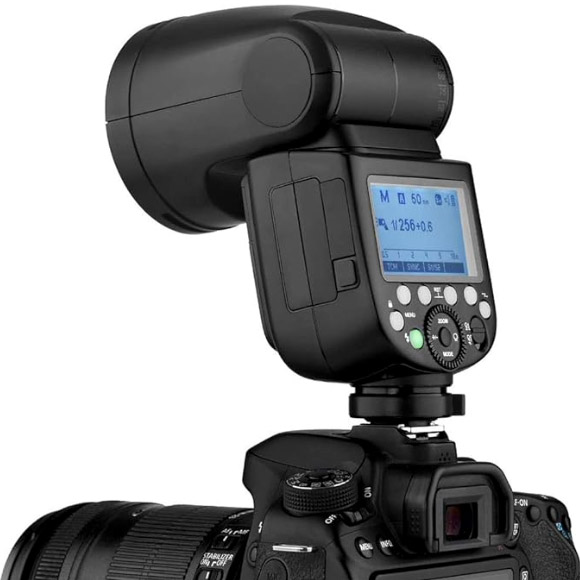
Find Godox V1-C Round Pricing on Amazon
Practical Tips for Potential Godox Flash Buyers
Whether you're considering the Godox V1 flash or leaning more towards the Godox speedlight options in the V860 series, always take into account the type of photography you're into.
A Professional Photographer's Advice on Buying Godox Flash Heads
Drawing from his vast experience, Jeff suggests potential buyers consider the type of photography they are into and how each flash model can uniquely serve their needs.

Find Godox V1-C Round Pricing on Amazon

Look up the Godox V860III on Amazon

Buy the Godox V860II on Amazon
Godox V860III vs Godox V1: A Detailed Comparison
Perhaps the best reason to buy the older version of the Godox V860 series (the V860 II) is the lower price point. That's a valid reason. But if budget is not a constraint for you, the V860III is a better purchase. With that in mind, let's compare the Godox V860 III to the Godox V1.
The Godox V860III and V1 are two of the most popular on-camera flashes on the market. They are both feature-rich and well-built, but they have some key differences.
Zoom range
The V860III has a zoom range of 20-200mm, while the V1 has a zoom range of 28-105mm. This means that the V860III can be used with a wider range of lenses, including telephoto lenses.
Flash head shape
The V860III has a rectangular flash head, while the V1 has a round flash head. Round flash heads are known for producing more flattering light, so the V1 is a good choice for portrait photographers.
Modeling light
The V860III has a modeling light on the flash body, while the V1 has a modeling light on the flash head. This means that the V1's modeling light is more accurate in terms of how the light will fall on the subject.
Photographer's Comparative Insights
Jeff offers practical insights into the differences between the models, focusing on aspects like zoom range, flash head shape, and modeling light, which he has found crucial in his professional work.
Frequently Asked Questions About Godox Flash Units
What are the main differences between the Godox V1, V860II, and V860III flash units?
The primary differences between the Godox V1, V860II, and V860III include their design, battery performance, and user interface. The Godox V1 features a round head for more natural light spread and an advanced lithium battery for better performance. The V860II, being an older model, has a traditional rectangular head and slightly less battery efficiency. The V860III, the latest model, combines features from both predecessors with improvements such as a better battery life, quicker recycle times, and a more intuitive interface.
Which of these Godox flash models is best for professional wedding photography?
For professional wedding photography, the Godox V1 is often preferred due to its round head that provides soft, even light, which is ideal for capturing flattering portraits. Additionally, its quick recycle time and strong battery life allow photographers to shoot throughout an event without worrying about flash downtime or battery replacement.
Can the Godox V860II be used off-camera and if so, how?
Yes, the Godox V860II can be used off-camera. It is equipped with a built-in 2.4G wireless X system that allows it to be triggered remotely. Photographers can use a Godox X series transmitter to control the flash settings and trigger the unit from a distance, making it versatile for various lighting setups in studio or outdoor environments.
What are the advantages of the battery system in the Godox V860III over the V860II?
The Godox V860III features an improved lithium-ion battery compared to the V860II, offering a longer battery life and more stable performance in terms of recycle time. The V860III's battery can provide up to 450 full-power flashes per charge, with a recycle time of just 1.5 seconds at full power, which is a significant upgrade over the older model.
Is the Godox V1 compatible with all camera brands?
The Godox V1 flash is designed to be compatible with multiple camera brands including Canon, Nikon, Sony, Olympus, Panasonic, and Fuji. It includes a specific version for each brand, ensuring full compatibility with the respective camera's TTL system, which helps in achieving accurate exposure in various lighting conditions.
How does the user interface of the Godox V860III improve over its predecessors?
The Godox V860III has a user interface that features a more intuitive control panel with a clearer display and better navigation buttons. It also includes a new quick-lock hot shoe mechanism that simplifies the process of mounting and dismounting the flash from the camera. These improvements make it easier for photographers to adjust settings quickly and efficiently during shoots.
What is the difference between Godox V1 and V860III?
The Godox V1 features a round head for a more natural light spread, while the V860III has a traditional rectangular head. Both offer TTL, HSS, and wireless capabilities, but the V860III has improved battery life and user interface.
Is Godox V860III better than V860II?
The V860III includes enhanced battery life and a more advanced user interface compared to the V860II, making it a better choice for many photographers.
Which is better for portraits: Godox V1 or V860III?
The Godox V1 is often preferred for portraits due to its round head that provides softer and more even lighting, whereas the V860III is versatile for various photography styles.
Can the round head of the Godox V1 be considered a significant advantage over the rectangular heads of the V860II and V860III?
Yes, the round head of the Godox V1 is considered a significant advantage, especially in portrait photography, as it provides a more natural and soft light spread. This can mimic the effect of natural sunlight and reduces harsh shadows, which is preferable for most photographers seeking a flattering and professional look in their photos.
In Conclusion:
This article, enriched with Jeff Fried's personal experiences and insights, not only provides a technical comparison of the Godox V1, V860II, and V860III but also offers practical, real-world perspectives. Jeff's extensive use of these models in various commercial photography scenarios adds a layer of authenticity and practicality to this comparison, aiding photographers in making an informed choice.
Check out Jeff's commercial and personal work.
Buy Some Art
Join Our Exclusive Mailing List for Insider Access to Exciting Updates and Valuable Resources Delivered Directly to Your Inbox
